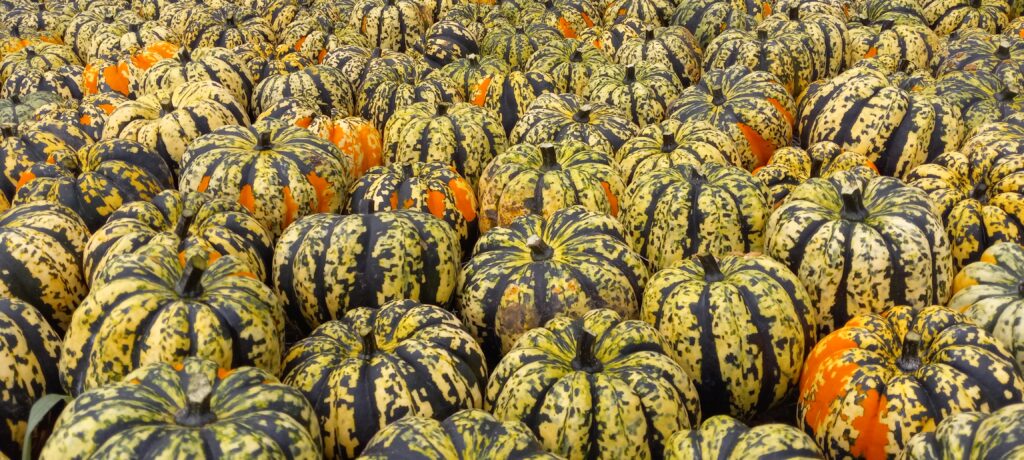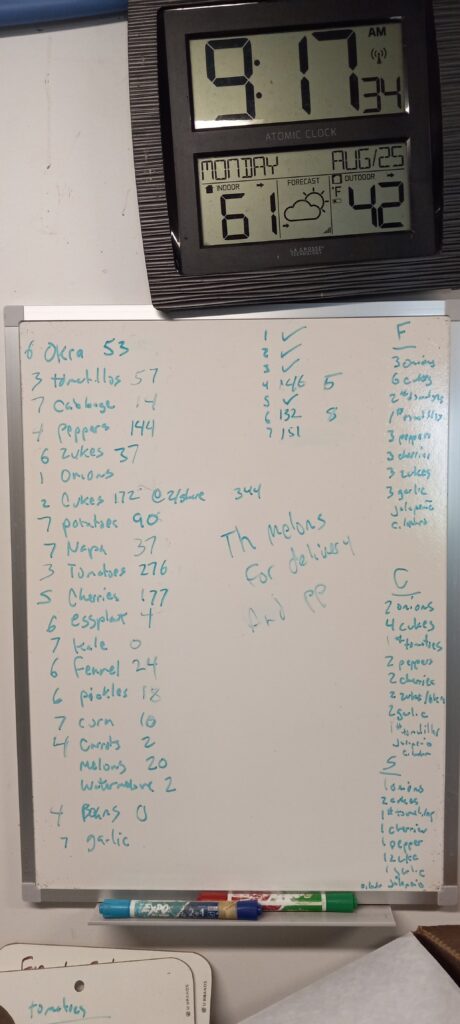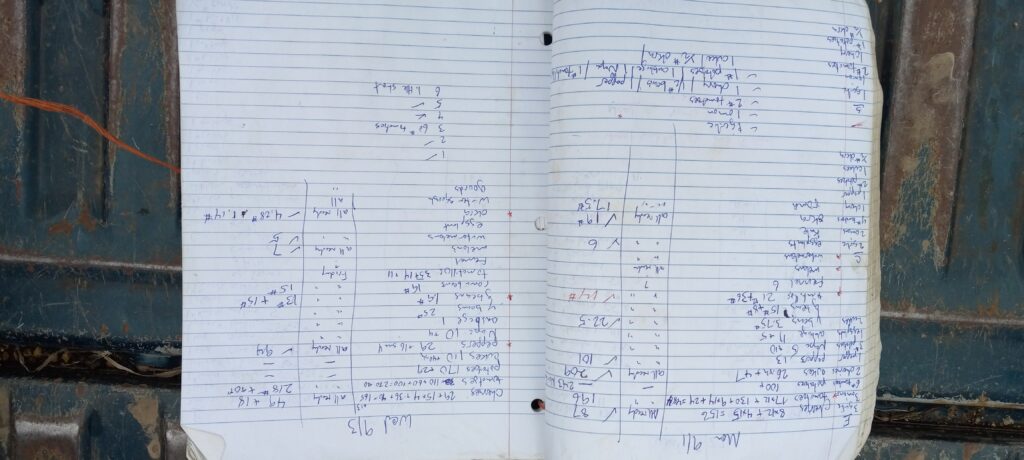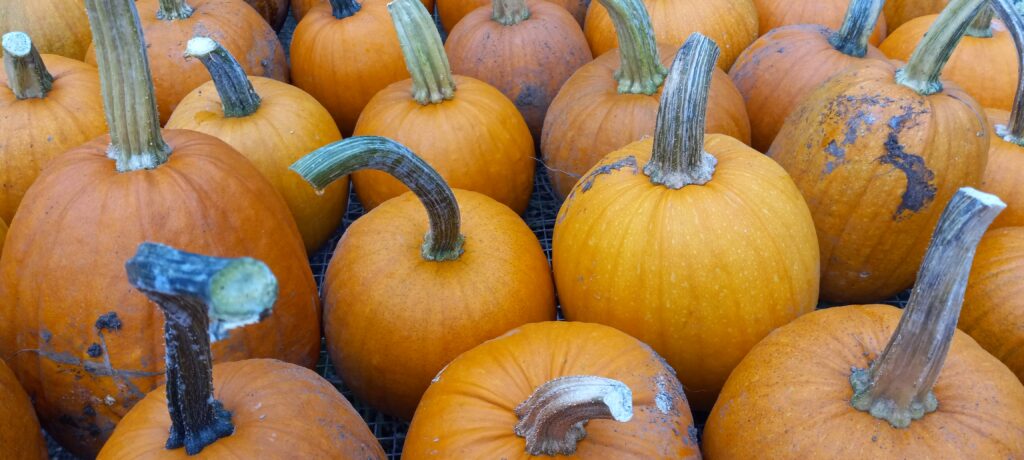
We’re still looking for help this fall. If you know anyone — including you — that has some time and would like to get dirty — or not, we can be flexible — send them our way!
Speaking of help, I think Friday might be a good day to take a mental health day from your regular job and come help us harvest all the winter squash. The squash looks really good right now and I’d like to get it in before it stops looking good. So if you can take some time to lend a hand on Friday I’d really appreciate it. Let’s start at 10:00 and go until it is all done. Let me know if you can make it!
Still taking pint size clamshell containers. Only pint size please.
Still planning on garlic planting on Saturday October 4th. Mark it on your calendar! It is easy work but takes a lot of time so a “many hands make light work” situation. We’ll start at the usual 1:00.

What will we have this week?
Carrots! Plus more tomatoes (but not as many) cherry tomatoes, some tomatillos, onions, garlic, peppers, some cabbages, some arugula, some kale, a few eggplants, some purple daikon radishes, some beans, some okra, and some other things I am forgetting.
It is an Egg, Flower and Coffee week. This is most likely the last week for flower bouquets. The plants just aren’t producing flowers, though I must say they do seem to be perking up a bit. Anyway, we’ll hand out gourds next week if we can harvest enough of them.
Farm News
One question I’ve been asked a number of times recently is how do we figure out what goes in each category in the pick-up tent and what goes in each of the delivery boxes. I have to say I’ve been reluctant to answer this question not because its proprietary but because it is so complicated and hard to describe. But I’ll give it a shot.
There are many factors that go into these decisions. Let’s look at some examples.
Some items like onions we like to give out every week in its own category. Onions seem to be used in many dishes so having them around is helpful. Plus they typically store well so if you don’t get to eating this week’s onions you can use them next week.
Some other situations are equally straightforward, like how many pints of cherry tomatoes do we have. Or how many cukes? If we have enough of any one item we’ll treat that as one category. The tricky part in this situation is we have to forecast whether the plants will continue to provide enough for the whole week for that to be one category. For example, we may have enough cucumbers to give out at two per share at the beginning of the week but will they continue to produce so that by the end of the week we can still give out two per share? This part is difficult but with the years of experience we typically do a reasonable job of this forecast.

A second situation is where we don’t have enough of a given item for every share to get one. Here we have to combine items into categories so that we have enough in the category to meet the needs. For example, let’s say we have 100 share for the day but only 60# of potatoes. We could give the potatoes their own category and give out 0.6# per share but that typically doesn’t work well. 0.6# of potatoes probably isn’t enough. So we find other items that have enough to fulfill the need. So maybe we also have 30# of carrots. Typically we give out carrots at 1/2# per share so we could combine these and meet the 100 items requirement.
However, we do have to take into account not only the future harvest opportunity and future need for the rest of the week as described above but we also have to consider member preferences. In our example, we feel carrots and potatoes are of approximately equal desirability. Everyone likes carrots and potatoes. And we’ve seen from the past that people choose them over some other things like radishes or eggplants. So combining these two makes sense. But if we put the potatoes with eggplants there is a very good chance that all the potatoes will be taken well before the eggplants vanish so the last folks will only get eggplants and never potatoes. We prefer everyone gets a choice if possible.
But, and there is always a but, the demand for a given item varies over the course of the season. When we first started harvesting cucumbers people would choose them over say eggplants. But as the season went on and our members were overwhelmed with cukes, the demand for eggplants over cukes would increase. People would rather figure out what to do with an eggplant than have yet more cucumbers. So we have to take this into account as well when setting up categories.

Another factor we have to take into account is what we will put into the delivery shares. With delivery shares we use the same categories we’ve previously defined for all shares and decide what items from each category go into the box. One factor in this is that each category needs to have enough of the items to fill the delivery share demand. In other words, if we have 50 delivery boxes there needs to be at least one item in the category that has 50 items. But that isn’t even exactly correct. As you know, we have two size shares (three if you include a couple of single shares that were grandfathered in). A FamliyShare gets three things from each category and a CoupleShare gets two things. So when we allocate items we need to take into account these factors. For example, we do not want to give a FamilyShare three cabbages. People typically don’t eat that much cabbage. So we give at most one cabbage per box and then have to choose another items from that category for a CoupleShare and two more items for the FamilyShare. Therefore, we need at least two items from that category where there is enough for every delivery share. Oh, and don’t forget, we have to ensure this works for the whole week and not just for today just like we did for the categories defined above. As I said, it’s complicated.
What else? Oh, we track what goes into each delivery share so that our delivery members don’t keep getting the same items week after week — unless of course that is what the farm is providing, say like cucumber this year. So if we put a cabbage in the delivery shares last week we won’t put them in this week. In that case we may have to move around items in the categories to provide an item that isn’t cabbage but has enough items to meet the delivery demand.
Another factor that goes into it is how we put items out in the pick-up tent for people to choose. Sometimes a category can have up to ten items. This is typical when crops are ramping up or down. We don’t put all ten out into the pick-up tent for people to choose from. We put maybe three or four items out and as some run out we’ll replace the item with a different item. We try to keep track of which days/times we put certain items out but it isn’t possible to record and account for every situation. But we do our best to mix it up enough so everyone gets an opportunity at everything over the course of the season. This is true with delivery boxes and in fact is far easier with delivery boxes since we get to decide what goes in the box.
Let’s see, what other factors go into the equation? With delivery boxes we have far more CoupleShares than FamilyShares, so sometimes when items are in low supply we can put the item in the FamilyShares but not the CoupleShare. Typically this means FamilyShares get the first items of a given crop when only a few are available. Then as the crop ramps up the CoupleShare will get it and the FamilyShare will get something else.
Sometimes, but not very often, we have to rearrange the categories later in the week when a crop doesn’t come in like we expected or if the demand for one item in a category was higher than we expected and so we need to add another items to that category. We record this too but it doesn’t typically change our future decisions — unless it is something special.

Very rarely we goof up and find our forecast for the rest of the week is completely wrong. Where we thought we have a ton of okra we find the okra plants are taking time off and now we are short. This doesn’t affect the on-farm people too often other than you don’t get okra that week but it does affect the delivery shares since we try to keep them essentially identical for the whole week. In this case we again record the discrepancy and make up for it the next week.
Finally — though I’m sure there are other factors I am forgetting — sometimes items come in in the middle of the week. Sweet corn is an example here (though not so much this season unfortunately). We like to pick sweet corn at peak ripeness and distribute it as quickly as possible. So if we determine it needs to be picked starting on Wednesday we do not wait until the following cycle — which would be Monday — to start picking it. We’ll harvest it on Wednesday, start distributing it that week and continue with it through the following Tuesday. Of course we make a record of it so we can ensure everyone gets that item — unless you switch pick-up days for on-farm pick-up. In this case if you typically pick-up on Tuesday the week of sweet corn starting on Wednesday, then switch to Thursday pick-up the next week, you would probably not get that week’s sweet corn.
This decision process typically takes 1/2 hour to an hour of one or two people conferring on what to do. So less time than it takes to write a newsletter but more time than we’d like.
Anyway, I don’t know if I fully described what we do but I do think I got across the point that it is complicated and AI is just not up to the challenge yet. So we’ll continue to use our old-fashion whiteboard to figure it out and record it in our spiral-bound notebook.
As always, feel free to send in questions, comments, suggestions, jokes, etc.
Recipe of the Week
I might have already put this recipe in a newsletter this season but since we have apples in FruitShare and some kale I thought why not send it out again. If you have blue cheese left from CheeseShare you can use it instead of the feta cheese.

Kale Feta Cranberry Salad
Ingredients
- 1 bunch kale chopped/shredded
- 8 oz feta cheese crumbled
- ½ c dried cranberries
- ½ c sliced almonds
- 1 medium apple sliced into bite-size pieces
Dressing
- ½ c olive oil
- ¼ c lemon juice
- 1 clove garlic minced or crushed
- 2 tsp dijon mustard
- ⅛ tsp black pepper
- ½ tsp kosher salt
Instructions
- Wash, stem and chop kale leaves into bite-sized pieces. Add to large bowl.
- Add feta, cranberries, sliced almonds and apple slices to kale.
- Whisk together olive oil, lemon juice, garlic, mustard, salt and pepper.
- Pour dressing over salad and toss to combine.
Notes
Joke of the Week
A physics professor was discussing a particularly complicated concept. An Agriculture student rudely interrupted to ask “Why do we have to learn this stuff?” The professor replied, “To save lives.” and continued the lecture. A few minutes later, the same student spoke up again. “How does knowing physics save lives?” he persisted. “It keeps the ignoramuses out of Ag school,” replied the professor.
